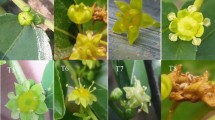Abstract
Plant flowering and breeding characteristics are important for us to understand the reproduction of plant populations. In this paper, we studied the reproduction characteristics of Jatropha curcas in Yuanjiang County (23°36′N, 101°00′E), Yunnan Province. The plant produces flowers in dichasial inflorescences. Normally, the flowers are unisexual, and male and female flowers are produced in the same inflorescence. Only a few male flowers are produced in an inflorescence, and fruits are produced only through pollination between different flowers from the same or different plants. By the treatments of emasculation, bagging and artificial pollination in this experiment, there were few but same fruit set ratios when the inflorescences were emasculated, bagged, or bagged with net, except artificial pollination treatments, which showed that Jatropha curcas could produce fruit through apomixis but not wind pollination. When the inflorescences were unbagged, unemasculated and with free pollination treatments, or bagged, emasculated and with artificial cross-pollination treatments, or unbagged, emasculated and with free pollination treatments, there were many fruits produced. It showed that Jatropha curcas shows outcrossing, is self-compatible, and demanding for pollinators. Normally, the male flowers open first and a few flowers bloom in one day in a raceme. These flowers last a long time in bloom. However, a large number of female flowers open from the third to the fifth day, with some female flowers opening first in a few raceme. This shows a tendency to promote xenogamy and minimize geitonogamy.
Similar content being viewed by others
References
Bawa K S, Perrv D R, Beach J H. 1985a. Reproductive biology of tropic lowland rain forest trees. I. Pollination systems. Amer. J. Bot., 72: 331–345
Bawa K S, Bullock S H, Perry D R, CoviIIe R E, Grayum M H. 1985b. Reproduive biology of tropic lowland rain forest trees. II. Polination systemes. Amer. J. Bot., 72: 346–356
Bullock S H. 1985. Breeding systems in the flora of a tropical deciduous forest in Mexico. Biotrop, 17: 287–301
Cruden R W. 1977. Pollen-ovule ratios: a conservative indicator of breeding systems in flowering plants. Evolution, 31: 32–46
Cruden R W. 1988. Temporal dioecism: Systematic breadth, associated traits and temporal patterns. Bot. Gaz., 149: 1–15
Dafni A. 1992. Pollination Ecology. New York: Oxford University Press, 1–57
Dulmen A V. 2001. Polination and phenology of flowers in the canopy of two contrasting rain forest types in Amazonia, Colombia. Plant Ecol., 153: 73–85
Editorial Committee of Flora China Nica of the Academy of Sciences of China. 1996. Flora of China. Beijing: Science Press, 44(2): 148 (in Chinese)
Faegri K, Pijl V D L. 1979. The Principles of Pollination Ecology. 3rd edn. Oxford: Pergamon Press, 151–154
Fang Y M. 1996. Plant Reproductive Ecology. Jinan: Shandong University Press, 1–56, 120–163 (in Chinese)
Grant V. 1981. Plant Speciation (2nd ed). New York: Columbia University Press
Guo Y H. 1994. Pollination biology and plant evolution. In: Chen J K, Yang J (eds.), Plant Evolutionary Biology. Wuhan: Wuhan University Press, 232–280 (in Chinese)
Les D H. 1988. Breeding systems, population structure, and evolution in hydrophilous angiosperms. Ann. Mo. Bot. Gard., 75, 819–835
Liu X J, Ding M M, Zhang G X, Zhao L, Li R J. 1997. Studies on flower biology and breeding system of Vicia L. in Northeast China. Bull. Bot. Res., 17(4): 421–429 (in Chinese with an English abstract)
Stebbins G L. 1970. Adaptive radiation in angiosperms, I. Pollination mechanisms. Ann. Rev. Ecol. Syst., 1: 307–326
Wyatt R. 1983. Pollinator plant interactions and the evolution of breeding systems. In: Real L (ed.), Pollination Biology. Florida: Academic Press, 51–95
Zhang D Y, Jiang X H. 2001. Mating system evolution, resource allocation, and genetic diversity in plants. Acta Phytoecol. Sin., 25(2): 130–143 (in Chinese with an English abstract)
Author information
Authors and Affiliations
Corresponding author
Rights and permissions
About this article
Cite this article
Luo, Cw., Li, K., Chen, Y. et al. Floral display and breeding system of Jatropha curcas L.. For. Stud. China 9, 114–119 (2007). https://doi.org/10.1007/s11632-007-0017-z
Received:
Accepted:
Issue Date:
DOI: https://doi.org/10.1007/s11632-007-0017-z




